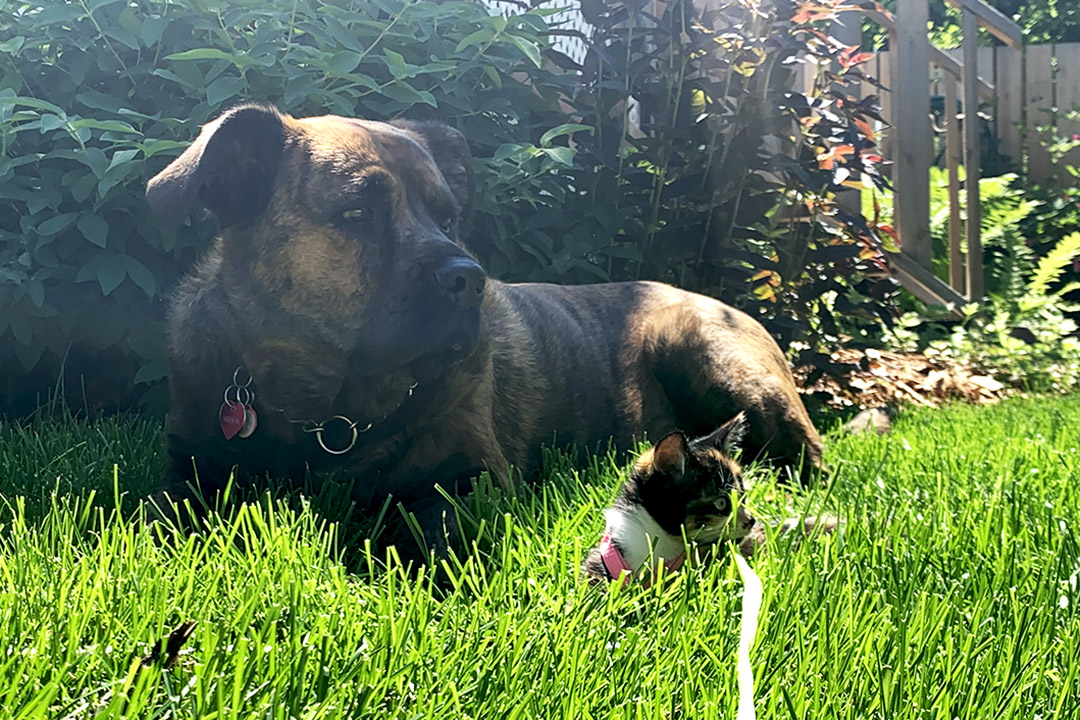
‘Bully breeds’ bans don’t address lack of training and owner awareness
Banning of dog breeds brings up important questions: are dog breeds causing the problem? Or is the problem caused by owners who don’t properly train their animals — or don’t train them at all?
By Katie FishMy nine-year-old dog, Meesha, dotes on her feline companion and wouldn’t hurt a fly.
But since Meesha is a mixed-breed dog that falls under the description of a “bully breed,” new legislation banning dogs that fall under this category would make it impossible for me to own her if I lived in Britain or in Ontario.
Bully breed is a term describing dog breeds that share similar physical characteristics such as a shorter muzzle and a large chest. The category includes American bulldogs, American pit bull terriers, boxers, bull mastiffs and any other breeds that are similar in appearance.
Although many different breeds are included in the bully breed category, all dogs within this group are often mislabelled as “pit bulls.” When a dog attack happens and the animal’s breed is unknown, many people assume that the aggressive animal must be a pit bull if it resembles the description of a bully breed.
Aggressive behaviour in dogs isn’t anything new: dog bite incidents are commonly reported on mainstream news and social media, and journalists and others are quick to identify the breed or type of the dog involved in the case.
These reports can cause widespread panic and perpetuate stereotyping of certain dog breeds. They can also contribute to misinformation about bully-breed dogs that continue to be labelled as aggressive and dangerous to the public. When this happens, communities bring about bans targeting all dogs that resemble “pit bulls” without recognizing individual breeds and misconceptions about dog behaviour.
For example, the province of Ontario introduced legislation in 2005 that restricts provincial residents from owning, breeding, transferring or importing pit bulls in Ontario. Specific breeds are listed within the law, but the restriction includes dogs that have an appearance and physical characteristics similar to the listed breeds.
Individual dogs that were already living in Ontario before the law came into effect must wear a muzzle in public, whether they’re aggressive or not. This same approach is being adopted in England where the country’s government recently announced additional breed bans to existing legislation due to dog attacks that allegedly involve bully breeds.
Banning of dog breeds brings up important questions: are dog breeds causing the problem, or is the problem caused by owners who don’t properly train their animals — or don’t train them at all?
Dr. Karen Machin (DVM, PhD) is a veterinarian, researcher and a resident in clinical animal behaviour at the Western College of Veterinary Medicine (WCVM). She regularly participates in dog bite prevention awareness campaigns for the public and often gives presentations to pet owners about this important topic.
As she points out in her 2021 presentation titled “Why Dogs Bite,” Machin sheds light on the environmental factors that influence why a dog could be showing aggressive behaviour and what the owner can do to better educate themselves on what to look for.
Machin talks about the vital points that owners need to address in training their dogs and preventing any accidents from occurring. With proper training and owner awareness, any dog has the potential to be safely integrated in public situations.
In turn, all dogs have the potential to bite. During my own experience working in the veterinary community for about five years, I have been bitten by “friendly” breeds such as golden retrievers, Labradors, German shepherds and huskies as well as smaller dogs.
These dogs were in high-stress environments and possibly in pain; biting is a typical response in these situations. The best way to combat biting accidents from happening is understanding the signs that dogs show before physically acting on their discomfort.
During my time working in veterinary clinics, I began to question the idea that certain dog breeds are aggressive when most of the bully breeds I have come into close contact with have been nothing but sweethearts — including my own dog.
I’ve investigated what I can do to prevent any aggressive accident involving my dog from happening. The key takeaway revolves around training my dog properly and ensuring that I have a good understanding of her personality.
With this training and education, I’m better prepared to assess each environment and to determine if certain situations are healthy for my dog to be part of — and when to avoid potential circumstances that could lead to negative situations.
Katie Fish of Okotoks, Alta., is a master’s student studying aquatic biology in the College of Arts and Science at the University of Saskatchewan. Dr. Maud Ferrari of the WCVM's Department of Veterinary Biomedical Sciences is Fish's graduate supervisor.
